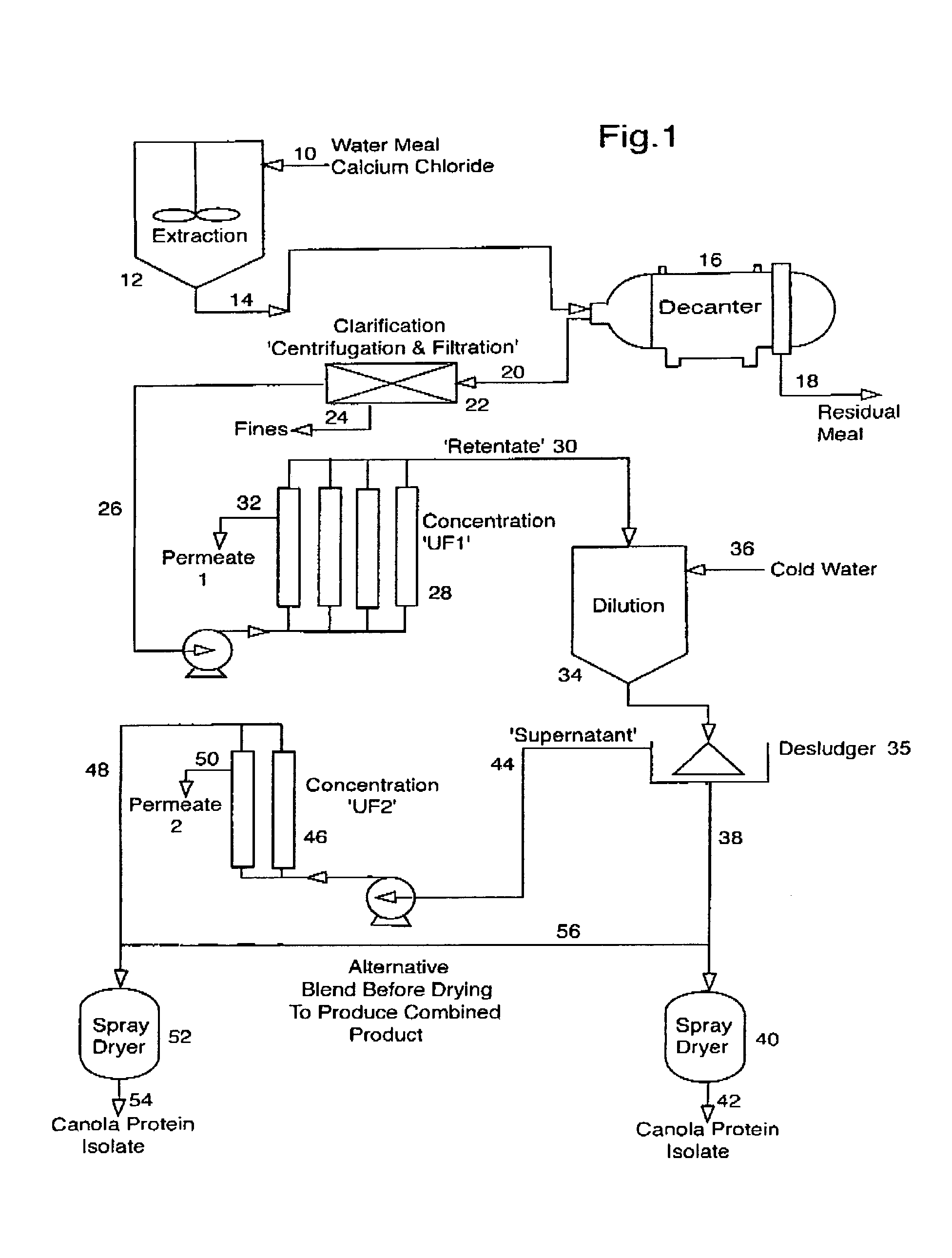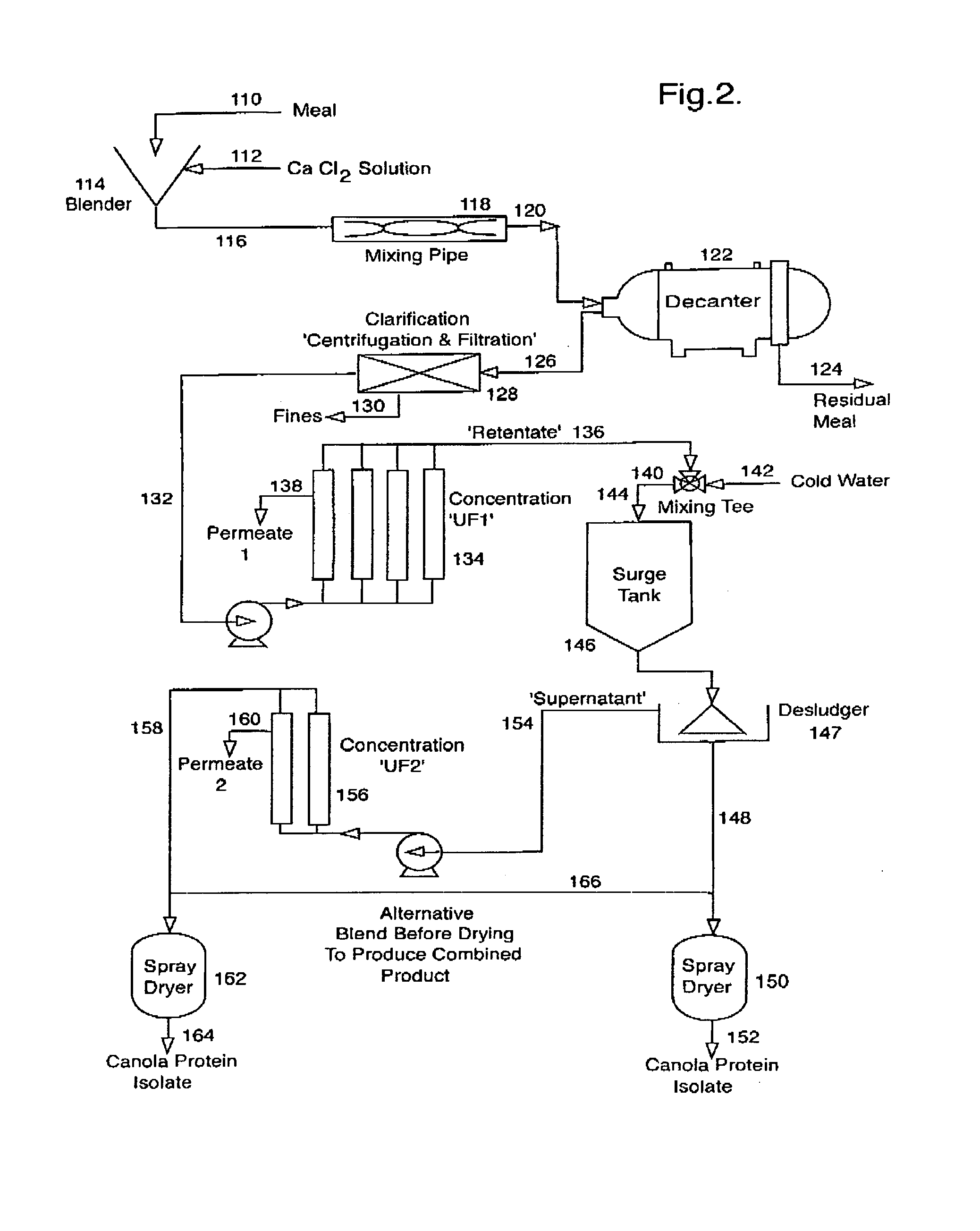Protein isolation procedures for reducing phytic acid
a technology of protein isolates and isolation procedures, which is applied in the field of protein isolate production, can solve the problems of adverse effects on the digestibility of protein isolates, and achieve the effects of reducing the phytic acid content of protein isolates, improving nutritional value, and reducing the phytic acid conten
- Summary
- Abstract
- Description
- Claims
- Application Information
AI Technical Summary
Benefits of technology
Problems solved by technology
Method used
Image
Examples
example 1
[0105]This Example describes the preparation of canola protein isolates.
[0106]“a” kg of commercial canola oil seed meal was added to “b” L of extraction solution, which was either 0.1M NaCl or 0.075M CaCl2, containing 0.05 wt % ascorbic acid at ambient temperature, agitated for 30 minutes to provide an aqueous protein solution having a protein content of “c” wt %. All protein contents were determined using a Leco FP528 Nitrogen Determinator. The residual canola meal was removed and the resulting protein solution was clarified by centrifugation and filtration to produce “d” L of filtered protein solution having a protein content of “e” % by weight.
[0107]A “f” L aliquot of the protein extract solution was reduced in volume to “g” L by concentration on a polyether sulfone (PES) membrane having a molecular weight cut-off of 100,000 daltons and then pasteurized at 60° C. for 10 minutes. The resulting pasteurized concentrated solution had a protein content of “h” % by weight.
[0108]The con...
example 2
[0112]This Example compares the phytic acid content of canola protein isolates prepared as described in Example 1.
[0113]The canola protein isolate samples, prepared as described in Example 1, were analyzed for phytic acid content by an ion-exchange / colourimetric method. The results obtained are set forth in the following Tables II and III:
[0114]
TABLE IISamplewt % Phytic AcidStd Deviation:AL022-J07-03A C300 w / NaCl1.550.08AL022-J07-03A C200 w / NaCl4.090.17AL022-J30-03A C300 w / CaCl20.430.00AL022-J30-03A C200 w / CaCl20.930.03
[0115]
TABLE IIISamplewt % Phytic AcidStd Deviation:AL022-L03-03A C300 w / CaCl20.850.06AL022-L03-03A C200 w / CaCl20.340.06
[0116]As may be seen from this data, extraction of the canola oil seed meal using sodium chloride under the same extraction conditions resulted in a higher phytic acid content when compared to extractions made with calcium chloride. The difference in the phytate levels was not as significant between the C200 and the C300 product when CaCl2 was used.
example 3
[0117]This Example describes laboratory scale experiments comparing extraction of canola oil seed meal with sodium chloride and calcium chloride.
[0118]A series of laboratory-scale experiments were performed. In the experiments, 15 g of commercial canola oil seed meal were combined with 150 ml of extraction solvent to provide a 10% w / v extraction. The mixture was stirred for 30 min. using an orbital shaker operating at 220 rpm at ambient temperature. The extraction solvents were 0.05 M CaCl2, 0.1 M NaCl and blends of 0.05M CaCl2 and 0.1M NaCl, combined by volume, in the following proportions:[0119]100% CaCl2 / 0% NaCl[0120]80% CaCl2 / 20% NaCl[0121]60% CaCl2 / 40% NaCl[0122]40% CaCl2 / 60% NaCl[0123]20% CaCl2 / 80% NaCl[0124]0% CaCl2 / 100% NaCl
[0125]The extracts were centrifuged at 10,000 g for 10 min to separate spent meal from the extract. The centrifuged extracts were filtered through 25 μm filter paper. The filtrates were centrifuged at 10,000 g for 20 min. 80 ml of centrifuged filtrates we...
PUM
| Property | Measurement | Unit |
|---|---|---|
| concentration | aaaaa | aaaaa |
| temperature | aaaaa | aaaaa |
| temperature | aaaaa | aaaaa |
Abstract
Description
Claims
Application Information
 Login to View More
Login to View More - R&D
- Intellectual Property
- Life Sciences
- Materials
- Tech Scout
- Unparalleled Data Quality
- Higher Quality Content
- 60% Fewer Hallucinations
Browse by: Latest US Patents, China's latest patents, Technical Efficacy Thesaurus, Application Domain, Technology Topic, Popular Technical Reports.
© 2025 PatSnap. All rights reserved.Legal|Privacy policy|Modern Slavery Act Transparency Statement|Sitemap|About US| Contact US: help@patsnap.com


